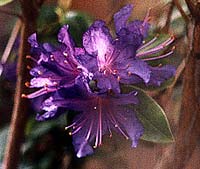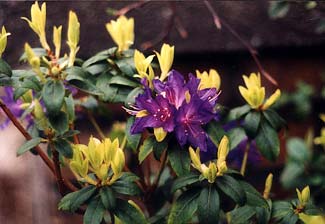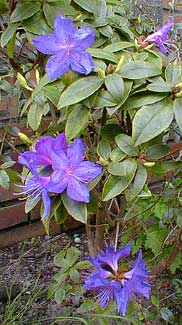 Rhododendron 'Mood Indigo'
Rhododendron 'Mood Indigo'
"Are not flowers the stars of the earth?
Are not our stars the flowers of heaven?"
-Clara Lucas Balfour
(1808-1878)
(1808-1878)
We obtained 'Mood Indigo' during the annual spring Rhododendron Species Foundation's two-day plant sale in 2002. Some of the plants sold at this event are way less expensive than in most nurseries, though others are the same prices or higher, but the main thing is the chance to obtain items not often seen in nurseries at all. 'Mood Indigo' is one of a handful of rare offerings we obtained that year.
People arrive ahead of time & stand behind a rope salivating. As soon as the rope is dropped & the crowd is let in, they take off at top speed running in & among the plants, flapping about wildly like starving bats scared they might not get a good enough mouthful of gnats.
 My tastes aren't ordinary enough that I ever seem to miss out on much for refusing to elbow & knock people over, though for failing to run I did miss out on a rarely offered trillium, a table full of which was emptied at once. Usually, the stuff that won't last through the first fifteen minutes of the sale turn out to be the cheapest "producty" stuff of no particular consquence, because most people are there for bargains & have no individual taste so might as well be getting their plants at WalMart. So I saunter & dawdle & investigate closely & rarely feel like I missed out.
My tastes aren't ordinary enough that I ever seem to miss out on much for refusing to elbow & knock people over, though for failing to run I did miss out on a rarely offered trillium, a table full of which was emptied at once. Usually, the stuff that won't last through the first fifteen minutes of the sale turn out to be the cheapest "producty" stuff of no particular consquence, because most people are there for bargains & have no individual taste so might as well be getting their plants at WalMart. So I saunter & dawdle & investigate closely & rarely feel like I missed out.I was on my second pass when I noted that nobody had yet chosen that lone 'Mood Indigo,' probably because it was not exactly bargain-priced. Most of the shrubs being offered at that stall were raised by the woman selling them & looked amateur-grown from cuttings, but this 'Mood Indigo' was gorgeously shaped in its limb structure, truly the best shrub she had brought to sell. I thanked her profusely for raising such a fine specimen & lugged it off to add to my horde.
 'Mood Indigo' was crossbred by the late Lester Brandt of Tacoma, Washington, whose best known creation was 'Kubla Khan.' Lester had the world's largest collection of books about rhododendrons, & his nursery provided many rhodies which are still thrilling visitors to the Washington Park Aboretum's famed "Azalea Way."
'Mood Indigo' was crossbred by the late Lester Brandt of Tacoma, Washington, whose best known creation was 'Kubla Khan.' Lester had the world's largest collection of books about rhododendrons, & his nursery provided many rhodies which are still thrilling visitors to the Washington Park Aboretum's famed "Azalea Way."Lester, alas, was a notorious curmudgeon, whose worst expectations in life were fulfilled two years before he died, when his house was broken into & he was beaten & robbed. He never recovered emotionally & his natural distrust of people spoilt his last days on earth.
Lester wrote the records for his hybridizations in code, which no one else was ever able to read, so the knowledge of the precise heritage of some of his plants died with him. To develop 'Mood Indigo,' he started with the Chinese Rhododendron augustinii ssp augustinii & pollinated it with unrecorded species or cultivar. The resulting 'Mood Indigo' was never registered but has gone into limited production even so.
It has an upright narrow growth habit with a ten-year height of five feet. It is slightly open to reveal its limb structure. It is slow-growing, & if someone had a specimen not already nicely formed, it wouldn't add limbs or size with any rapidity. Fortunately our specimen had an excellent structure & is elegant even when not in bloom.
I saw a review of this rhody that did not praise it, but I could barely imagine that it would get less than high marks, unless the desire was for such dense flowering that the bush disappears; it won't do that. In the three blooming seasons we've had it, it has never been floriferous, but the beauty of its smattering of is simply outstanding. It produces the deepest purple or indigo-blue flowers which in our yard begin to open in mid April (in slightly warmer areas it will begin blooming in March). It is one of the most striking colors on any of our rhodies.
Plus the unique leaf characteristics add considerable interest. It has sweet-smelling small evergreen leaves dense along the slim branches. The foliage is bronzy in winter. The flower close-up at the top of the page was taken in April (2002), then a couple weeks later in May I got the second photo of some of the blooms which have by this time been joined by new leaf growth which begins so soft & yellow they're almost like blossoms until these young leaves harden into green.
The third photo was taken the following early-April (2003), again showing how thinly but attractively flowered it becomes. To see more of this shrub, see the 'Mood Indigo' Page of the Rhodies & Azaleas Blossoms Gallery.
This shrub is named for the tune partly composed by Duke Ellington, who would doubtless have been delighted by the appropriation, since he also wrote a less famous tune called "Azalea."